University Strategic Management Report: BMW Company Analysis
VerifiedAdded on 2021/12/28
|23
|5318
|65
Report
AI Summary
This report provides a comprehensive analysis of BMW's strategic management, examining its position within the automotive industry and its strategic direction. The analysis begins with an overview of BMW's Key Performance Indicators (KPIs), comparing them with those of competitors like Volkswagen and Toyota to assess its market performance. The report then delves into BMW's strategic direction using tools such as the Ansoff Matrix, exploring market penetration, product development, diversification, and market development strategies. Additionally, the BCG Matrix is employed to evaluate BMW's strategic business units. The report concludes with a critical evaluation of BMW's overall strategy, identifying areas for improvement and offering recommendations to strengthen its market position. The strong brand image of the company is well appreciated by the consumers, however, recommendations have been made to further enhance its brand image.
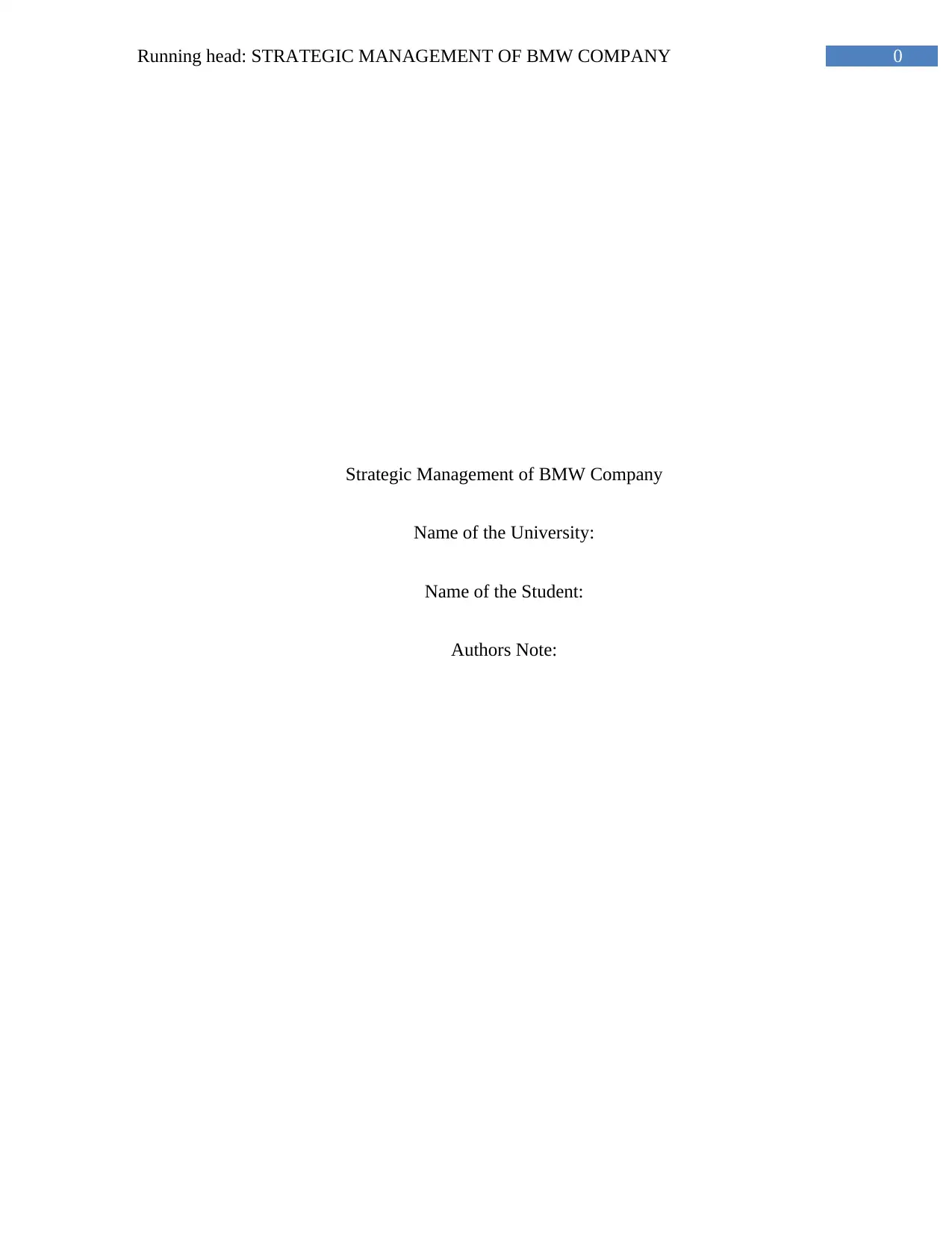
0Running head: STRATEGIC MANAGEMENT OF BMW COMPANY
Strategic Management of BMW Company
Name of the University:
Name of the Student:
Authors Note:
Strategic Management of BMW Company
Name of the University:
Name of the Student:
Authors Note:
Paraphrase This Document
Need a fresh take? Get an instant paraphrase of this document with our AI Paraphraser
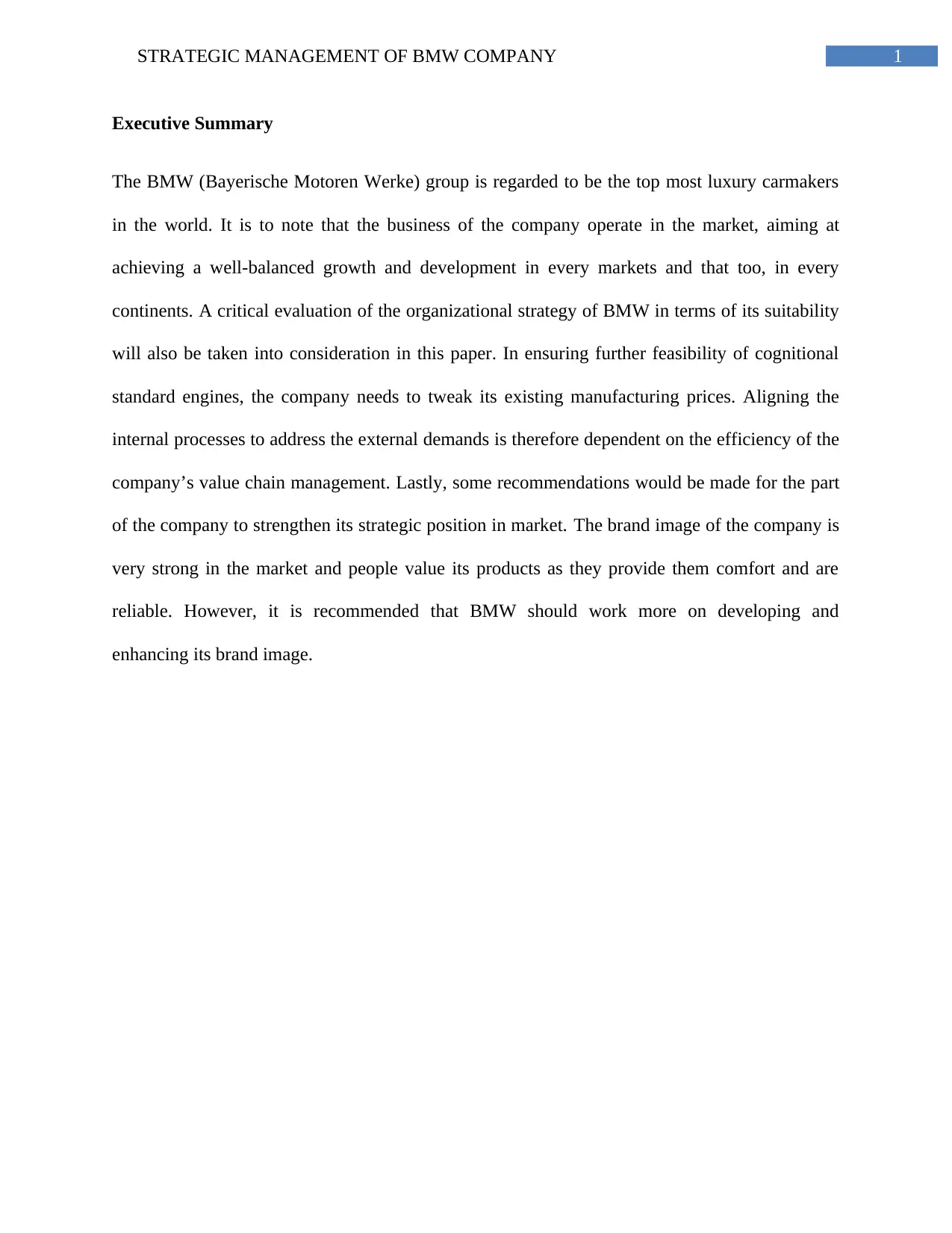
1STRATEGIC MANAGEMENT OF BMW COMPANY
Executive Summary
The BMW (Bayerische Motoren Werke) group is regarded to be the top most luxury carmakers
in the world. It is to note that the business of the company operate in the market, aiming at
achieving a well-balanced growth and development in every markets and that too, in every
continents. A critical evaluation of the organizational strategy of BMW in terms of its suitability
will also be taken into consideration in this paper. In ensuring further feasibility of cognitional
standard engines, the company needs to tweak its existing manufacturing prices. Aligning the
internal processes to address the external demands is therefore dependent on the efficiency of the
company’s value chain management. Lastly, some recommendations would be made for the part
of the company to strengthen its strategic position in market. The brand image of the company is
very strong in the market and people value its products as they provide them comfort and are
reliable. However, it is recommended that BMW should work more on developing and
enhancing its brand image.
Executive Summary
The BMW (Bayerische Motoren Werke) group is regarded to be the top most luxury carmakers
in the world. It is to note that the business of the company operate in the market, aiming at
achieving a well-balanced growth and development in every markets and that too, in every
continents. A critical evaluation of the organizational strategy of BMW in terms of its suitability
will also be taken into consideration in this paper. In ensuring further feasibility of cognitional
standard engines, the company needs to tweak its existing manufacturing prices. Aligning the
internal processes to address the external demands is therefore dependent on the efficiency of the
company’s value chain management. Lastly, some recommendations would be made for the part
of the company to strengthen its strategic position in market. The brand image of the company is
very strong in the market and people value its products as they provide them comfort and are
reliable. However, it is recommended that BMW should work more on developing and
enhancing its brand image.
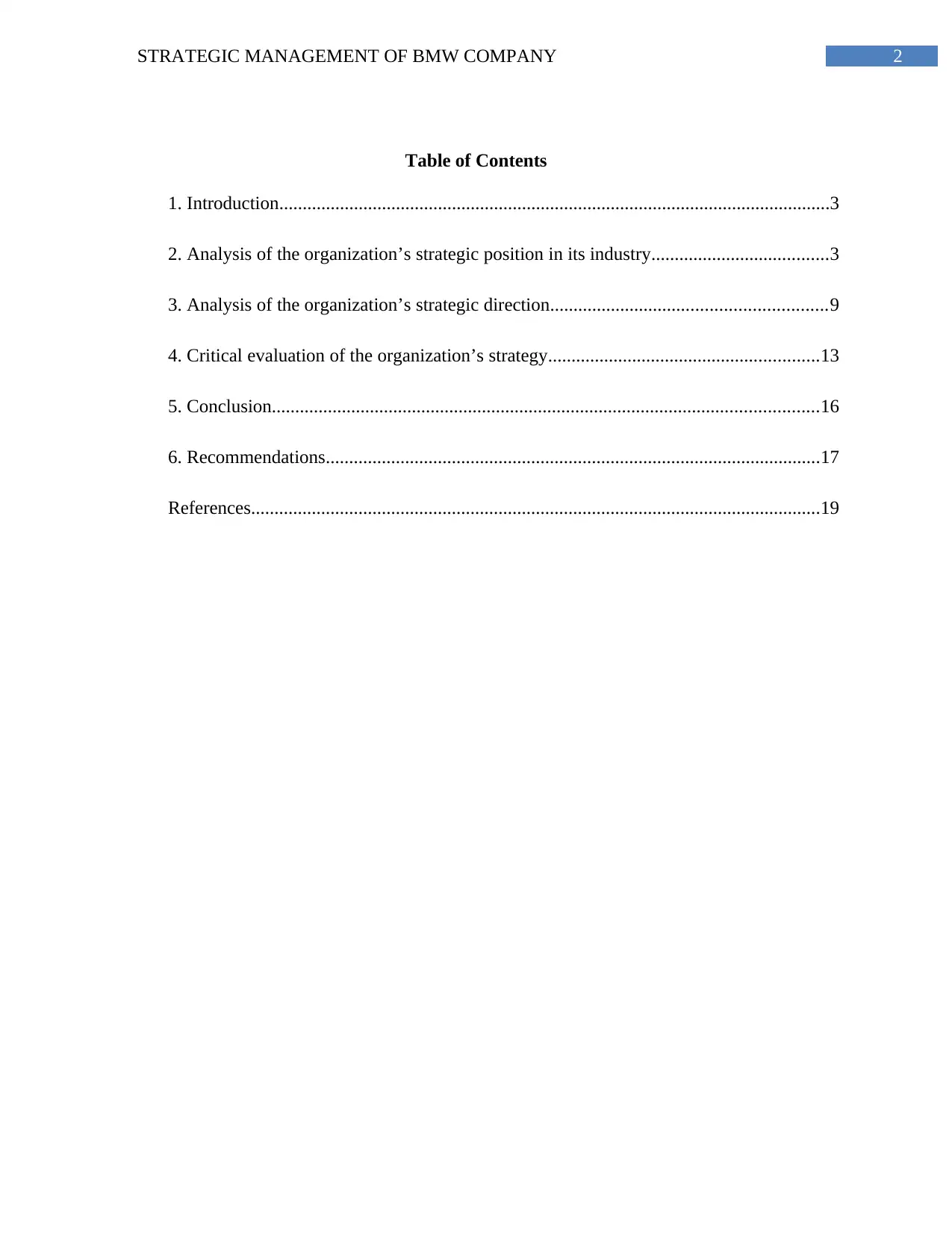
2STRATEGIC MANAGEMENT OF BMW COMPANY
Table of Contents
1. Introduction......................................................................................................................3
2. Analysis of the organization’s strategic position in its industry......................................3
3. Analysis of the organization’s strategic direction...........................................................9
4. Critical evaluation of the organization’s strategy..........................................................13
5. Conclusion.....................................................................................................................16
6. Recommendations..........................................................................................................17
References..........................................................................................................................19
Table of Contents
1. Introduction......................................................................................................................3
2. Analysis of the organization’s strategic position in its industry......................................3
3. Analysis of the organization’s strategic direction...........................................................9
4. Critical evaluation of the organization’s strategy..........................................................13
5. Conclusion.....................................................................................................................16
6. Recommendations..........................................................................................................17
References..........................................................................................................................19
⊘ This is a preview!⊘
Do you want full access?
Subscribe today to unlock all pages.

Trusted by 1+ million students worldwide
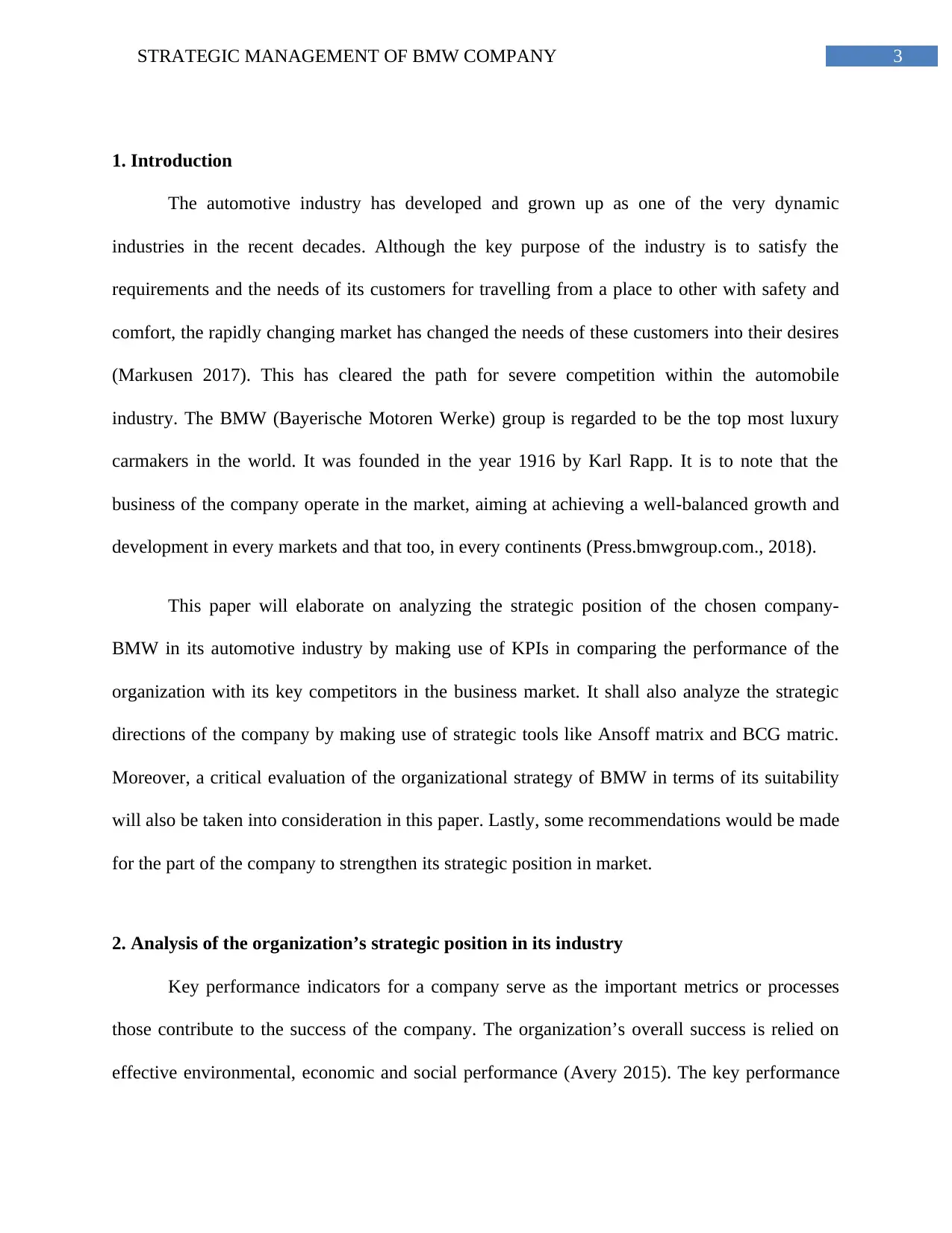
3STRATEGIC MANAGEMENT OF BMW COMPANY
1. Introduction
The automotive industry has developed and grown up as one of the very dynamic
industries in the recent decades. Although the key purpose of the industry is to satisfy the
requirements and the needs of its customers for travelling from a place to other with safety and
comfort, the rapidly changing market has changed the needs of these customers into their desires
(Markusen 2017). This has cleared the path for severe competition within the automobile
industry. The BMW (Bayerische Motoren Werke) group is regarded to be the top most luxury
carmakers in the world. It was founded in the year 1916 by Karl Rapp. It is to note that the
business of the company operate in the market, aiming at achieving a well-balanced growth and
development in every markets and that too, in every continents (Press.bmwgroup.com., 2018).
This paper will elaborate on analyzing the strategic position of the chosen company-
BMW in its automotive industry by making use of KPIs in comparing the performance of the
organization with its key competitors in the business market. It shall also analyze the strategic
directions of the company by making use of strategic tools like Ansoff matrix and BCG matric.
Moreover, a critical evaluation of the organizational strategy of BMW in terms of its suitability
will also be taken into consideration in this paper. Lastly, some recommendations would be made
for the part of the company to strengthen its strategic position in market.
2. Analysis of the organization’s strategic position in its industry
Key performance indicators for a company serve as the important metrics or processes
those contribute to the success of the company. The organization’s overall success is relied on
effective environmental, economic and social performance (Avery 2015). The key performance
1. Introduction
The automotive industry has developed and grown up as one of the very dynamic
industries in the recent decades. Although the key purpose of the industry is to satisfy the
requirements and the needs of its customers for travelling from a place to other with safety and
comfort, the rapidly changing market has changed the needs of these customers into their desires
(Markusen 2017). This has cleared the path for severe competition within the automobile
industry. The BMW (Bayerische Motoren Werke) group is regarded to be the top most luxury
carmakers in the world. It was founded in the year 1916 by Karl Rapp. It is to note that the
business of the company operate in the market, aiming at achieving a well-balanced growth and
development in every markets and that too, in every continents (Press.bmwgroup.com., 2018).
This paper will elaborate on analyzing the strategic position of the chosen company-
BMW in its automotive industry by making use of KPIs in comparing the performance of the
organization with its key competitors in the business market. It shall also analyze the strategic
directions of the company by making use of strategic tools like Ansoff matrix and BCG matric.
Moreover, a critical evaluation of the organizational strategy of BMW in terms of its suitability
will also be taken into consideration in this paper. Lastly, some recommendations would be made
for the part of the company to strengthen its strategic position in market.
2. Analysis of the organization’s strategic position in its industry
Key performance indicators for a company serve as the important metrics or processes
those contribute to the success of the company. The organization’s overall success is relied on
effective environmental, economic and social performance (Avery 2015). The key performance
Paraphrase This Document
Need a fresh take? Get an instant paraphrase of this document with our AI Paraphraser
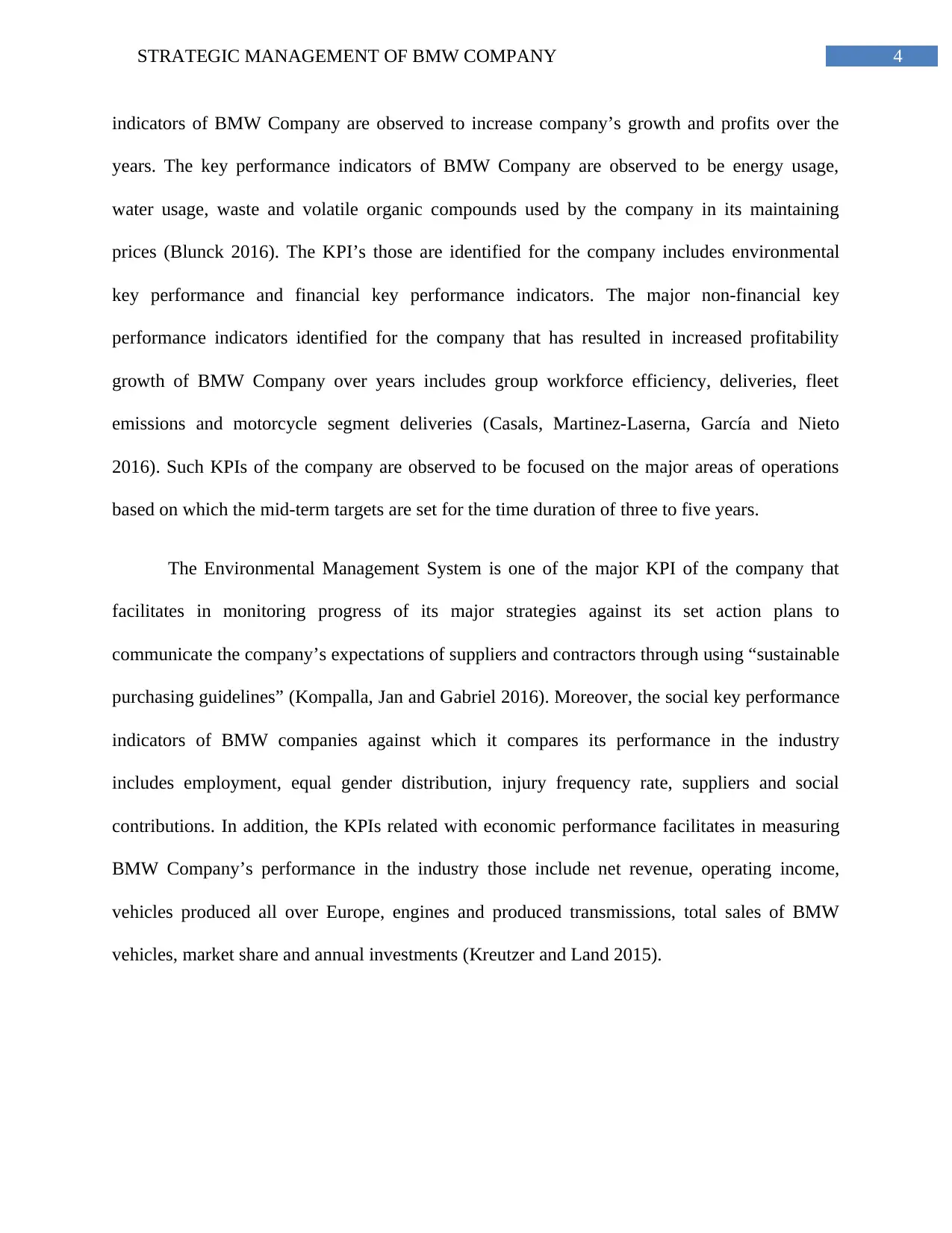
4STRATEGIC MANAGEMENT OF BMW COMPANY
indicators of BMW Company are observed to increase company’s growth and profits over the
years. The key performance indicators of BMW Company are observed to be energy usage,
water usage, waste and volatile organic compounds used by the company in its maintaining
prices (Blunck 2016). The KPI’s those are identified for the company includes environmental
key performance and financial key performance indicators. The major non-financial key
performance indicators identified for the company that has resulted in increased profitability
growth of BMW Company over years includes group workforce efficiency, deliveries, fleet
emissions and motorcycle segment deliveries (Casals, Martinez-Laserna, García and Nieto
2016). Such KPIs of the company are observed to be focused on the major areas of operations
based on which the mid-term targets are set for the time duration of three to five years.
The Environmental Management System is one of the major KPI of the company that
facilitates in monitoring progress of its major strategies against its set action plans to
communicate the company’s expectations of suppliers and contractors through using “sustainable
purchasing guidelines” (Kompalla, Jan and Gabriel 2016). Moreover, the social key performance
indicators of BMW companies against which it compares its performance in the industry
includes employment, equal gender distribution, injury frequency rate, suppliers and social
contributions. In addition, the KPIs related with economic performance facilitates in measuring
BMW Company’s performance in the industry those include net revenue, operating income,
vehicles produced all over Europe, engines and produced transmissions, total sales of BMW
vehicles, market share and annual investments (Kreutzer and Land 2015).
indicators of BMW Company are observed to increase company’s growth and profits over the
years. The key performance indicators of BMW Company are observed to be energy usage,
water usage, waste and volatile organic compounds used by the company in its maintaining
prices (Blunck 2016). The KPI’s those are identified for the company includes environmental
key performance and financial key performance indicators. The major non-financial key
performance indicators identified for the company that has resulted in increased profitability
growth of BMW Company over years includes group workforce efficiency, deliveries, fleet
emissions and motorcycle segment deliveries (Casals, Martinez-Laserna, García and Nieto
2016). Such KPIs of the company are observed to be focused on the major areas of operations
based on which the mid-term targets are set for the time duration of three to five years.
The Environmental Management System is one of the major KPI of the company that
facilitates in monitoring progress of its major strategies against its set action plans to
communicate the company’s expectations of suppliers and contractors through using “sustainable
purchasing guidelines” (Kompalla, Jan and Gabriel 2016). Moreover, the social key performance
indicators of BMW companies against which it compares its performance in the industry
includes employment, equal gender distribution, injury frequency rate, suppliers and social
contributions. In addition, the KPIs related with economic performance facilitates in measuring
BMW Company’s performance in the industry those include net revenue, operating income,
vehicles produced all over Europe, engines and produced transmissions, total sales of BMW
vehicles, market share and annual investments (Kreutzer and Land 2015).
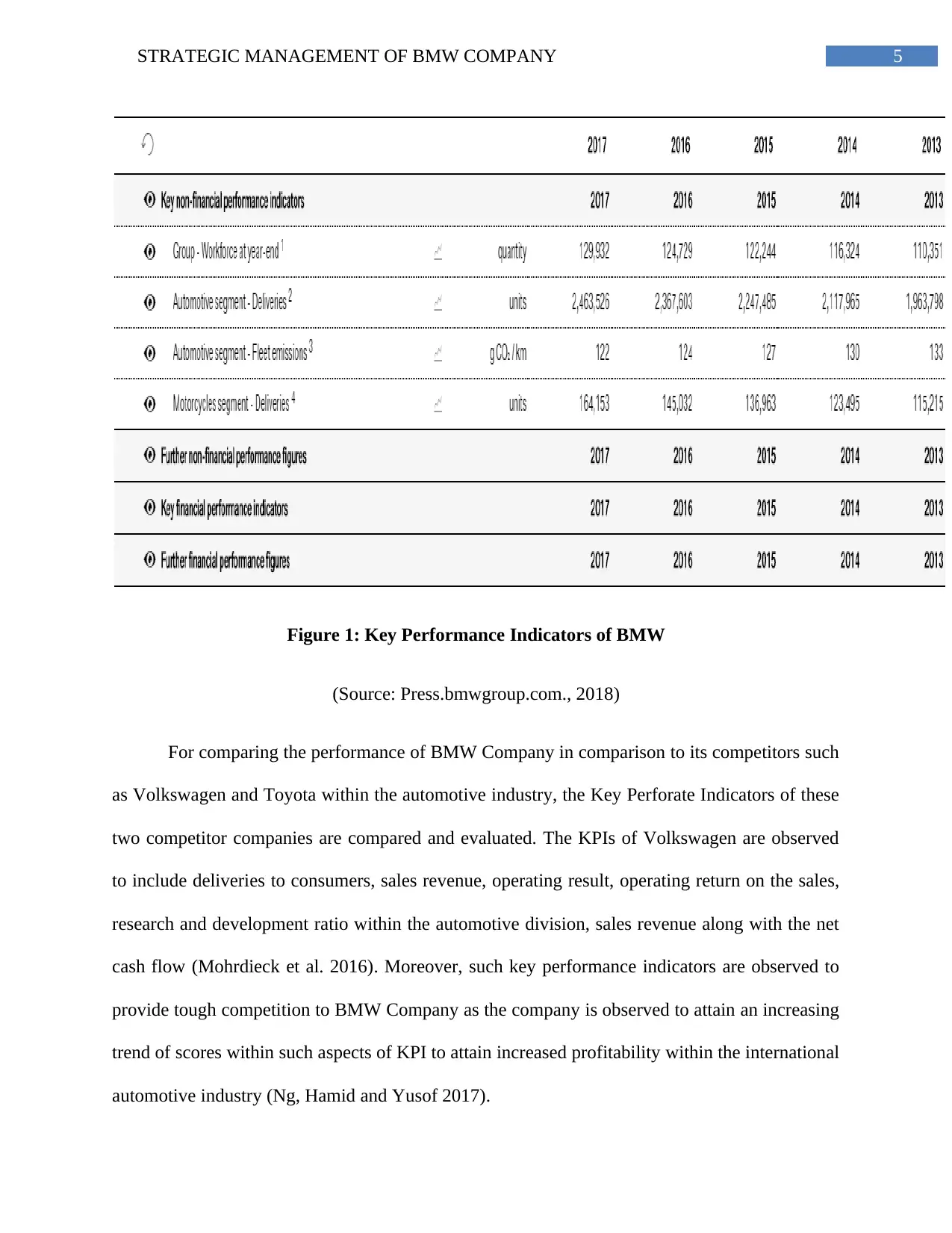
5STRATEGIC MANAGEMENT OF BMW COMPANY
Figure 1: Key Performance Indicators of BMW
(Source: Press.bmwgroup.com., 2018)
For comparing the performance of BMW Company in comparison to its competitors such
as Volkswagen and Toyota within the automotive industry, the Key Perforate Indicators of these
two competitor companies are compared and evaluated. The KPIs of Volkswagen are observed
to include deliveries to consumers, sales revenue, operating result, operating return on the sales,
research and development ratio within the automotive division, sales revenue along with the net
cash flow (Mohrdieck et al. 2016). Moreover, such key performance indicators are observed to
provide tough competition to BMW Company as the company is observed to attain an increasing
trend of scores within such aspects of KPI to attain increased profitability within the international
automotive industry (Ng, Hamid and Yusof 2017).
Figure 1: Key Performance Indicators of BMW
(Source: Press.bmwgroup.com., 2018)
For comparing the performance of BMW Company in comparison to its competitors such
as Volkswagen and Toyota within the automotive industry, the Key Perforate Indicators of these
two competitor companies are compared and evaluated. The KPIs of Volkswagen are observed
to include deliveries to consumers, sales revenue, operating result, operating return on the sales,
research and development ratio within the automotive division, sales revenue along with the net
cash flow (Mohrdieck et al. 2016). Moreover, such key performance indicators are observed to
provide tough competition to BMW Company as the company is observed to attain an increasing
trend of scores within such aspects of KPI to attain increased profitability within the international
automotive industry (Ng, Hamid and Yusof 2017).
⊘ This is a preview!⊘
Do you want full access?
Subscribe today to unlock all pages.

Trusted by 1+ million students worldwide

6STRATEGIC MANAGEMENT OF BMW COMPANY
Volkswagen has effective key performance indicators in positioning itself as a profitable
automobile manufacturer and these KPIs are indicated in its annual report. Such KPIs has
positioned the company as one of the leading automobile manufacturer economically and
ecologically. For attaining such goal the major KPIs for the company include meeting
stakeholder’s expectations, information technology and quality assurance, procurement,
production along with research and development (Plenter 2017). Volkswagen Company has also
considered implementing strong performance management systems that has facilitated in
attaining improved company efficiency.
Moreover, another KPI identified for the company is the performance based remuneration
component that facilitates the company in recognizing employees’ individual achievements. In
addition, few other financial and non-financial key performance indicators have been indentified
that has facilitated the company in competing with BMW Company over years (Sánchez et al.
2017). The KPIs are identified to be operating return on sales, research and development in
automotive division, net cash flow in company and net liquidity in the automotive direction.
Such KPIs is observed to increase sales of Volkswagen by 45% in the year 2017, generated
increased response to marketing by 166%, improved return on investment of marketing by 42%
and facilitated the company in attaining increased revenues per event (Schmalfuss et al. 2015). In
addition, the KPIs identified for Volkswagen also includes safety leadership, consumer safety,
fleet management, governance, transparency and product energy innovation.
Volkswagen has effective key performance indicators in positioning itself as a profitable
automobile manufacturer and these KPIs are indicated in its annual report. Such KPIs has
positioned the company as one of the leading automobile manufacturer economically and
ecologically. For attaining such goal the major KPIs for the company include meeting
stakeholder’s expectations, information technology and quality assurance, procurement,
production along with research and development (Plenter 2017). Volkswagen Company has also
considered implementing strong performance management systems that has facilitated in
attaining improved company efficiency.
Moreover, another KPI identified for the company is the performance based remuneration
component that facilitates the company in recognizing employees’ individual achievements. In
addition, few other financial and non-financial key performance indicators have been indentified
that has facilitated the company in competing with BMW Company over years (Sánchez et al.
2017). The KPIs are identified to be operating return on sales, research and development in
automotive division, net cash flow in company and net liquidity in the automotive direction.
Such KPIs is observed to increase sales of Volkswagen by 45% in the year 2017, generated
increased response to marketing by 166%, improved return on investment of marketing by 42%
and facilitated the company in attaining increased revenues per event (Schmalfuss et al. 2015). In
addition, the KPIs identified for Volkswagen also includes safety leadership, consumer safety,
fleet management, governance, transparency and product energy innovation.
Paraphrase This Document
Need a fresh take? Get an instant paraphrase of this document with our AI Paraphraser

7STRATEGIC MANAGEMENT OF BMW COMPANY
Figure 2: Key Performance Indicators of Volkswagen
(Source: Schnellbach and Reinhart 2015)
The key performance indicator of Toyota that has facilitated the company in successfully
competing with BMW in automobile market includes certain effective financial and non-
financial indicators. Such KPIs include measuring performance against energy usage per vehicle,
water usage per vehicle, VOC emissions per vehicle and waste produced per vehicle (Schoettle
and Sivak 2017). In addition, certain other important KPIs identified for Toyota that ensures its
success includes strength of brand identity, Toyota production system, revenue growth from its
Figure 2: Key Performance Indicators of Volkswagen
(Source: Schnellbach and Reinhart 2015)
The key performance indicator of Toyota that has facilitated the company in successfully
competing with BMW in automobile market includes certain effective financial and non-
financial indicators. Such KPIs include measuring performance against energy usage per vehicle,
water usage per vehicle, VOC emissions per vehicle and waste produced per vehicle (Schoettle
and Sivak 2017). In addition, certain other important KPIs identified for Toyota that ensures its
success includes strength of brand identity, Toyota production system, revenue growth from its
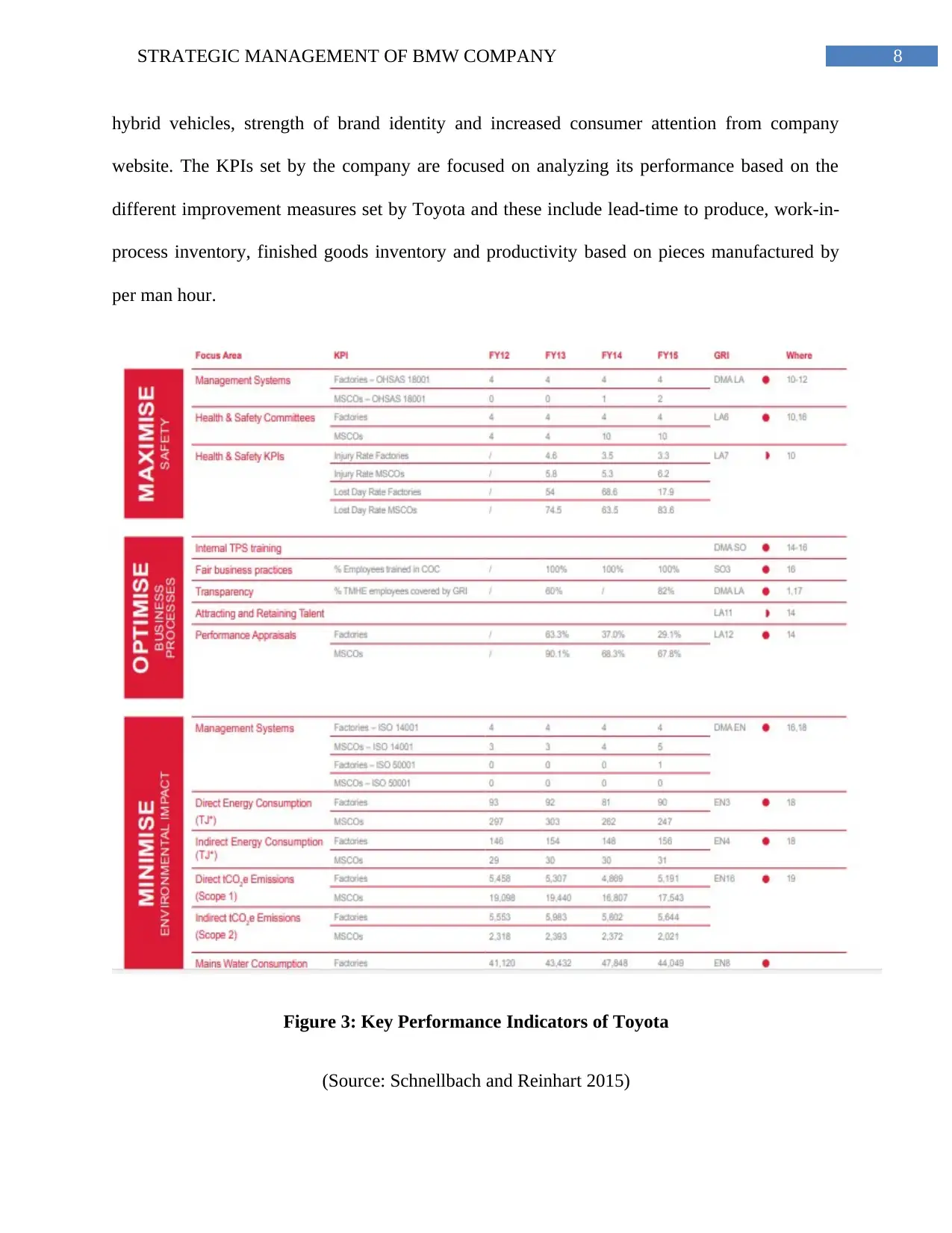
8STRATEGIC MANAGEMENT OF BMW COMPANY
hybrid vehicles, strength of brand identity and increased consumer attention from company
website. The KPIs set by the company are focused on analyzing its performance based on the
different improvement measures set by Toyota and these include lead-time to produce, work-in-
process inventory, finished goods inventory and productivity based on pieces manufactured by
per man hour.
Figure 3: Key Performance Indicators of Toyota
(Source: Schnellbach and Reinhart 2015)
hybrid vehicles, strength of brand identity and increased consumer attention from company
website. The KPIs set by the company are focused on analyzing its performance based on the
different improvement measures set by Toyota and these include lead-time to produce, work-in-
process inventory, finished goods inventory and productivity based on pieces manufactured by
per man hour.
Figure 3: Key Performance Indicators of Toyota
(Source: Schnellbach and Reinhart 2015)
⊘ This is a preview!⊘
Do you want full access?
Subscribe today to unlock all pages.

Trusted by 1+ million students worldwide

9STRATEGIC MANAGEMENT OF BMW COMPANY
3. Analysis of the organization’s strategic direction
Ansoff Matrix
The Ansoff Matrix
Like all the other originations in the present business world, BMW too follow some
strategic development directions so as to expand its business as well as increase its sales. Ansoff
matrix is one of the popular tools that helps such organizations in developing some strategic
directions which they could follow in regard to the range of products and services and the
markets by taking in context the potential of the expectations of the stakeholders of the
organization (Neykov, Antov and Brezin 2017). As it is depicted from the figure above, there are
a total of four strategic development directions. BMW follows all of them in its own way. They
are discussed below:
3. Analysis of the organization’s strategic direction
Ansoff Matrix
The Ansoff Matrix
Like all the other originations in the present business world, BMW too follow some
strategic development directions so as to expand its business as well as increase its sales. Ansoff
matrix is one of the popular tools that helps such organizations in developing some strategic
directions which they could follow in regard to the range of products and services and the
markets by taking in context the potential of the expectations of the stakeholders of the
organization (Neykov, Antov and Brezin 2017). As it is depicted from the figure above, there are
a total of four strategic development directions. BMW follows all of them in its own way. They
are discussed below:
Paraphrase This Document
Need a fresh take? Get an instant paraphrase of this document with our AI Paraphraser
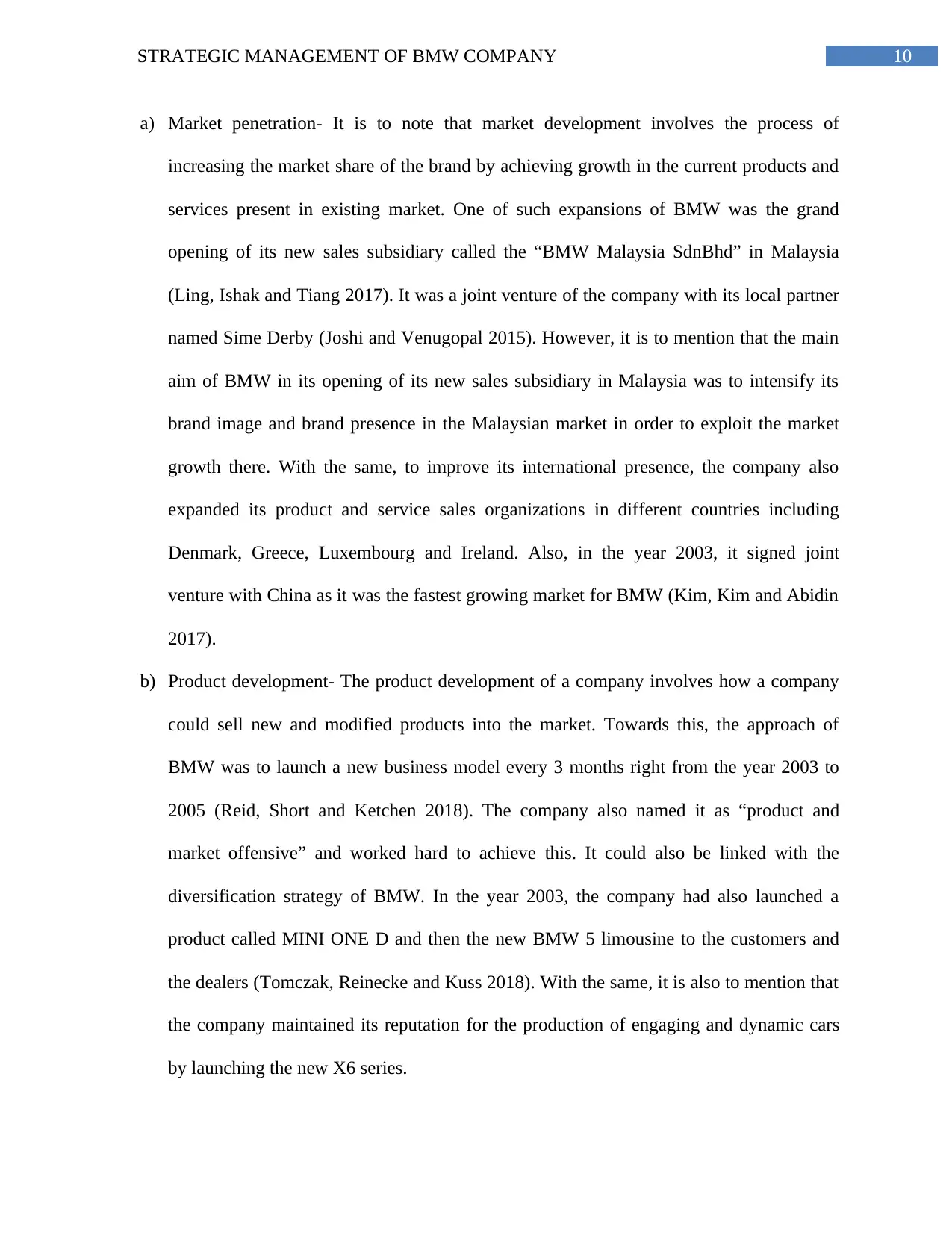
10STRATEGIC MANAGEMENT OF BMW COMPANY
a) Market penetration- It is to note that market development involves the process of
increasing the market share of the brand by achieving growth in the current products and
services present in existing market. One of such expansions of BMW was the grand
opening of its new sales subsidiary called the “BMW Malaysia SdnBhd” in Malaysia
(Ling, Ishak and Tiang 2017). It was a joint venture of the company with its local partner
named Sime Derby (Joshi and Venugopal 2015). However, it is to mention that the main
aim of BMW in its opening of its new sales subsidiary in Malaysia was to intensify its
brand image and brand presence in the Malaysian market in order to exploit the market
growth there. With the same, to improve its international presence, the company also
expanded its product and service sales organizations in different countries including
Denmark, Greece, Luxembourg and Ireland. Also, in the year 2003, it signed joint
venture with China as it was the fastest growing market for BMW (Kim, Kim and Abidin
2017).
b) Product development- The product development of a company involves how a company
could sell new and modified products into the market. Towards this, the approach of
BMW was to launch a new business model every 3 months right from the year 2003 to
2005 (Reid, Short and Ketchen 2018). The company also named it as “product and
market offensive” and worked hard to achieve this. It could also be linked with the
diversification strategy of BMW. In the year 2003, the company had also launched a
product called MINI ONE D and then the new BMW 5 limousine to the customers and
the dealers (Tomczak, Reinecke and Kuss 2018). With the same, it is also to mention that
the company maintained its reputation for the production of engaging and dynamic cars
by launching the new X6 series.
a) Market penetration- It is to note that market development involves the process of
increasing the market share of the brand by achieving growth in the current products and
services present in existing market. One of such expansions of BMW was the grand
opening of its new sales subsidiary called the “BMW Malaysia SdnBhd” in Malaysia
(Ling, Ishak and Tiang 2017). It was a joint venture of the company with its local partner
named Sime Derby (Joshi and Venugopal 2015). However, it is to mention that the main
aim of BMW in its opening of its new sales subsidiary in Malaysia was to intensify its
brand image and brand presence in the Malaysian market in order to exploit the market
growth there. With the same, to improve its international presence, the company also
expanded its product and service sales organizations in different countries including
Denmark, Greece, Luxembourg and Ireland. Also, in the year 2003, it signed joint
venture with China as it was the fastest growing market for BMW (Kim, Kim and Abidin
2017).
b) Product development- The product development of a company involves how a company
could sell new and modified products into the market. Towards this, the approach of
BMW was to launch a new business model every 3 months right from the year 2003 to
2005 (Reid, Short and Ketchen 2018). The company also named it as “product and
market offensive” and worked hard to achieve this. It could also be linked with the
diversification strategy of BMW. In the year 2003, the company had also launched a
product called MINI ONE D and then the new BMW 5 limousine to the customers and
the dealers (Tomczak, Reinecke and Kuss 2018). With the same, it is also to mention that
the company maintained its reputation for the production of engaging and dynamic cars
by launching the new X6 series.
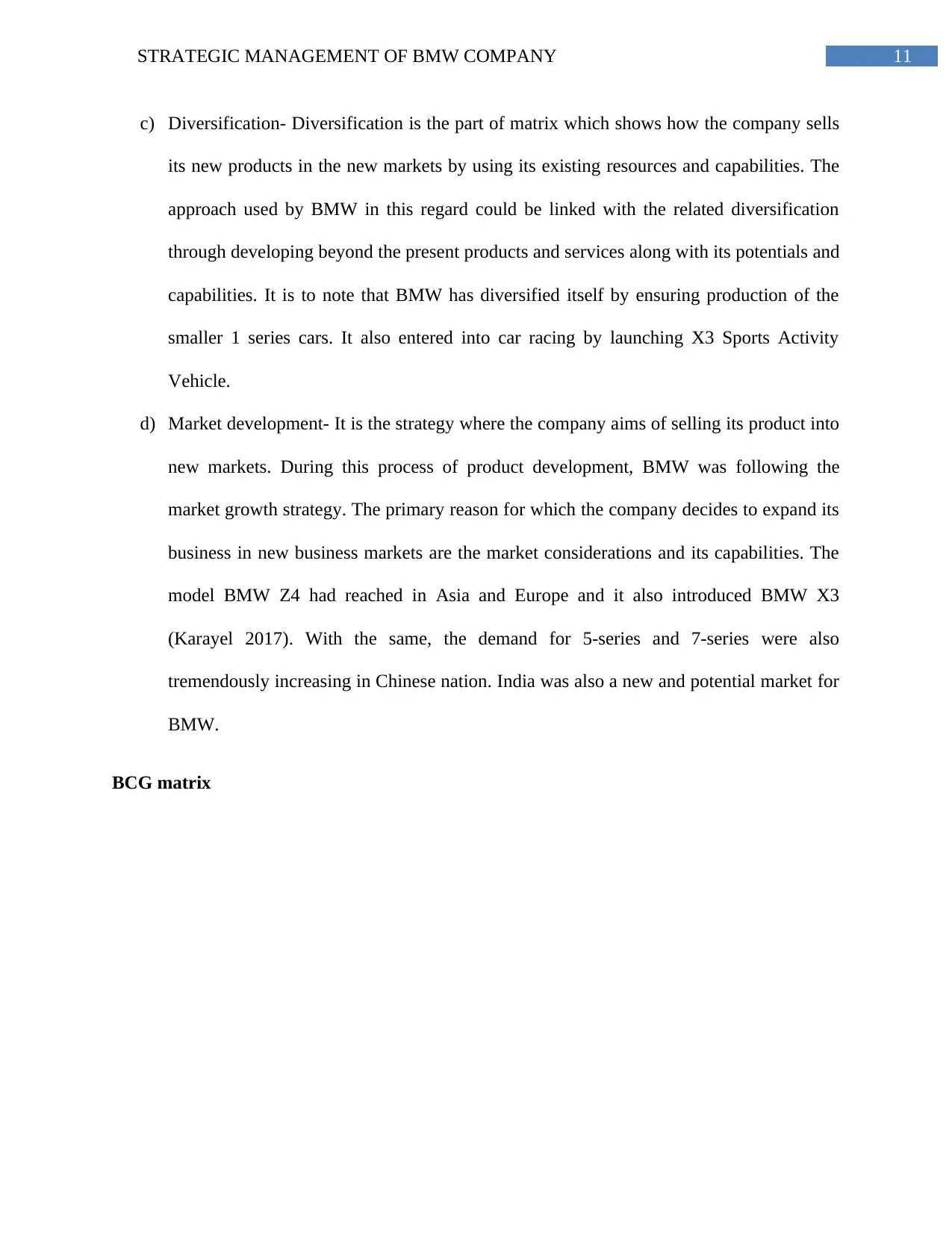
11STRATEGIC MANAGEMENT OF BMW COMPANY
c) Diversification- Diversification is the part of matrix which shows how the company sells
its new products in the new markets by using its existing resources and capabilities. The
approach used by BMW in this regard could be linked with the related diversification
through developing beyond the present products and services along with its potentials and
capabilities. It is to note that BMW has diversified itself by ensuring production of the
smaller 1 series cars. It also entered into car racing by launching X3 Sports Activity
Vehicle.
d) Market development- It is the strategy where the company aims of selling its product into
new markets. During this process of product development, BMW was following the
market growth strategy. The primary reason for which the company decides to expand its
business in new business markets are the market considerations and its capabilities. The
model BMW Z4 had reached in Asia and Europe and it also introduced BMW X3
(Karayel 2017). With the same, the demand for 5-series and 7-series were also
tremendously increasing in Chinese nation. India was also a new and potential market for
BMW.
BCG matrix
c) Diversification- Diversification is the part of matrix which shows how the company sells
its new products in the new markets by using its existing resources and capabilities. The
approach used by BMW in this regard could be linked with the related diversification
through developing beyond the present products and services along with its potentials and
capabilities. It is to note that BMW has diversified itself by ensuring production of the
smaller 1 series cars. It also entered into car racing by launching X3 Sports Activity
Vehicle.
d) Market development- It is the strategy where the company aims of selling its product into
new markets. During this process of product development, BMW was following the
market growth strategy. The primary reason for which the company decides to expand its
business in new business markets are the market considerations and its capabilities. The
model BMW Z4 had reached in Asia and Europe and it also introduced BMW X3
(Karayel 2017). With the same, the demand for 5-series and 7-series were also
tremendously increasing in Chinese nation. India was also a new and potential market for
BMW.
BCG matrix
⊘ This is a preview!⊘
Do you want full access?
Subscribe today to unlock all pages.

Trusted by 1+ million students worldwide
1 out of 23
Related Documents
Your All-in-One AI-Powered Toolkit for Academic Success.
+13062052269
info@desklib.com
Available 24*7 on WhatsApp / Email
![[object Object]](/_next/static/media/star-bottom.7253800d.svg)
Unlock your academic potential
Copyright © 2020–2025 A2Z Services. All Rights Reserved. Developed and managed by ZUCOL.




